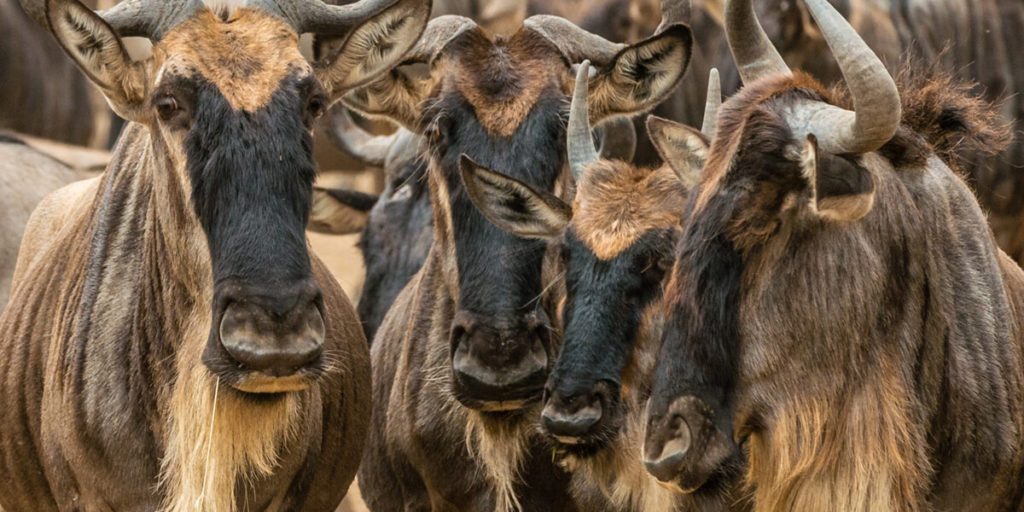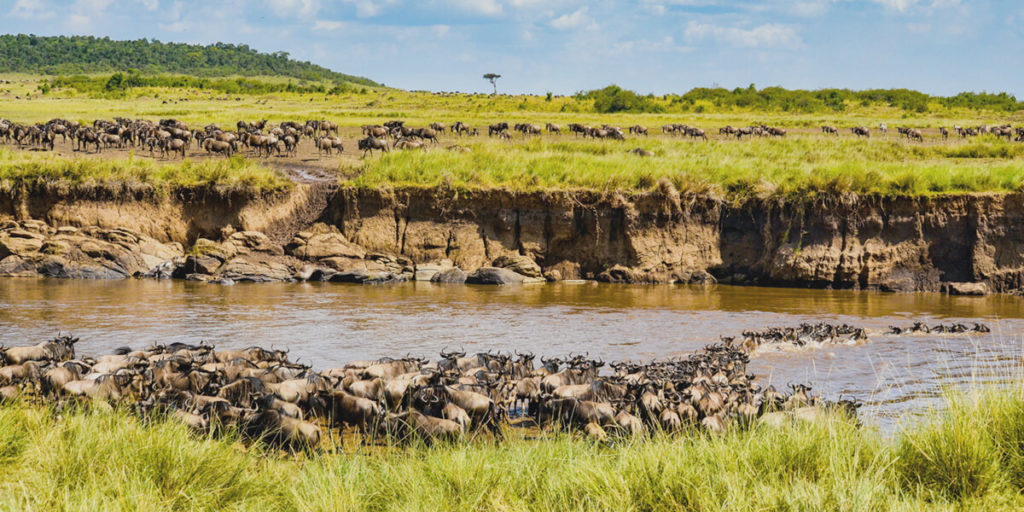Wildebeest belong to the Antelope species and are also known as Gnus. They have become the heartbeat of nature’s cycle for the Masai Mara Savannah wilderness in Kenya. These white-bearded species with an overcast grey coat have a distinctive black mane.
They gallop in large herds, together with numerous herds of other Antelope species and the striped East African Zebras within the ‘Masai Mara -Serengeti’ ecosystem, and appear thunderously menacing.
These herds move where the “grass is greener” and follow the rains within the Masai Mara-Serengeti ecosystem reserves. Since they are herbivorous, they feed upon the Savannah grasses and sustain these grasses and flora habitats, supplementing their droppings and excreta.
When watering at seasonal lakes or water holes, the sights of their massive herds are fascinating for visitors and the Mara carnivores.

The wildebeest migration is immensely the most astounding spectacles of nature and the wildlife world.
It is an annual migration of thousands of Wildebeest (approx. 1.5 million) in a loop course. Along with the Wildebeest are large herds of Zebra, Grant’s Gazelle, Thompson’s Gazelle, Elands, and Impalas across the Kenyan border, into the Mara reserve, crossing the Mara River, which is jammed with the Nile Crocodiles. These crocodiles are ferocious hunters and opportunistic predators awaiting the arrival of the Gnus and the different antelopes.
At its prime, this majestic wildlife phenomenon can be seen close-up, in the Mara reserve, at different crossings along the Mara River and its subsidiaries, between July and September of every year. Despite the deadly Crocs, menacing Hippos, the majestic Lions, the sly and shy Leopards, the spirited Cheetahs, the migrating and galloping Gnu beasts do not get deterred in seeking their fresh fodder.
The amazing sights of the Wildebeest constantly battling for survival against the predatory reptiles, big cats, and other dangers of the African jungle make the Migration period an exciting and enthralling time to visit Kenya.
The relentless motion of the multiple herds crossing the vast Savannah Mara plains, against many odds, is a natural wonder and presents sights to behold. While the numerous aspects of the migrating Wildebeest offer thrilling experiences, the Mara River crossings are the most awesome.
The raw and sensual nature of the sheer numbers of the Antelopes crossing the river at different precarious points is full of wow factor. The Wildebeest bravely challenge and outmaneuver the bullying hippo herds and the stealthy crocodiles, revealing the Mara wilderness’s savageness.

The drama that unfolds cannot be captured in photographs but leaves permanent impressions of the Mara wilderness magnificence in one’s psyche. It can be a poignantly humbling experience of Mother Earth’s magnanimousness that would be etched forever in the heart.
In anticipation, the Mara River crossings are the extraordinary climax of the Wildebeest migration as it takes one through explosions of emotions and awe.
The graceful Giraffes, with a complete aerial view of the whole scenario, seem to hold their breath for the charge into the river by the herds. The impressive sight of the initial mass of Wildebeest, madly dashing into the river, face to face with the submerged Hippos and Crocodiles, while Lions lurk at the opposite banks, would make one long to visit the Mara year after year to witness this surviving wonder of nature.
Lost into the wild and want to witness such a migration with your naked eyes?
Congratulations, you have landed at the right place. To book your migration safari(s), contact us.
We are your trusted safari and travel advisors and planners. We offer bespoke Safaris to fulfill your dream of a Kenyan Safari with our vast experience and trusted safari designers and guides.
- Safari Souk Limited, Centre Point, 4th Floor, Parklands Road, Nairobi, Kenya
- +254748103291
- sales@safarisouk.com
our Links
Useful links
© 2024 Safari Souk Limited. All rights reserved.
Designed and Maintenance by Ampwake Group.